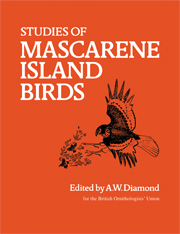Book contents
- Frontmatter
- Contents
- List of contributors
- Foreword
- Introduction
- I The native avifauna of the Mascarene Islands
- 1 An ecological history of the Mascarene Islands, with particular reference to extinctions and introductions of land vertebrates
- 2 The fossil record
- 3 Vocalisations of the endemic land-birds of the Mascarene Islands
- II The surviving native birds of Mauritius
- 4 The ecology of the smaller land-birds of Mauritius
- 5 The larger land-birds of Mauritius
- III The surviving native birds of Réunion and Rodrigues
- 6 The ecology of the surviving native land-birds of Réunion
- 7 Notes on the nesting of Procellariif ormes in Réunion
- 8 Observations on the surviving endemic birds of Rodrigues
- IV Measurements and weights
- 9 Measurements and weights of the surviving endemic birds of the Mascarenes and their eggs
- References
- Index
5 - The larger land-birds of Mauritius
Published online by Cambridge University Press: 04 August 2010
- Frontmatter
- Contents
- List of contributors
- Foreword
- Introduction
- I The native avifauna of the Mascarene Islands
- 1 An ecological history of the Mascarene Islands, with particular reference to extinctions and introductions of land vertebrates
- 2 The fossil record
- 3 Vocalisations of the endemic land-birds of the Mascarene Islands
- II The surviving native birds of Mauritius
- 4 The ecology of the smaller land-birds of Mauritius
- 5 The larger land-birds of Mauritius
- III The surviving native birds of Réunion and Rodrigues
- 6 The ecology of the surviving native land-birds of Réunion
- 7 Notes on the nesting of Procellariif ormes in Réunion
- 8 Observations on the surviving endemic birds of Rodrigues
- IV Measurements and weights
- 9 Measurements and weights of the surviving endemic birds of the Mascarenes and their eggs
- References
- Index
Summary
Mauritius Kestrel Falco punctatus (Temminck 1823; mangeur de poules (mañzer d'pul)
Introduction
The Mauritius Kestrel was a little-known falcon until the current series of studies on its biology was started in January 1973 by Dr S. A. Temple (Temple 1977a, McKelvey 1977c, 1978, Jones 1980d, Jones et al. 1981, Jones & Owadally 1982b). I have drawn widely upon the unpublished manuscript of Temple (1978c) and have endeavoured to bring it up to date in the light of recent research. (Some of the following material also appears in Jones & Owadally (1985) (Ed.).)
Taxonomy
Brown & Amadon (1968) placed the Mauritius Kestrel in a super-species with the European Kestrel F. tinnunculus, Moluccan Kestrel F. moluccensis, Australian Kestrel F. cenchroides, Madagascar Kestrel F. newtoni, Seychelles Kestrel F. araea, and perhaps the American Kestrel F. sparverius. They also regarded the Lesser Kestrel F. naumanni, Greater Kestrel F. rupicoloides and the Fox Kestrel F. alopex as being typical kestrels. Fox (1977) kept the above grouping but gave them sub-generic status. Cade (1982) kept the sub-genus, calling it tinnunculus, but considered F. rupicoloides and F. alopex to have diverged earlier from the rest of the group.
Sub-generic status for the typical kestrels is more desirable than placing them in a single super-species. Within Brown & Amadon's super-species, F. punctatus and F. araea are too divergent to justify such a close grouping. It would, however, be reasonable to place the kestrels which appear to be of recent radiation from F. tinnunculus, or a common ancestor, in a single super-species. These would be the allopatric F. tinnunculus, F. sparverius, F. newtoni, F. cenchroides and F. moluccensis.
- Type
- Chapter
- Information
- Studies of Mascarene Island Birds , pp. 208 - 300Publisher: Cambridge University PressPrint publication year: 1987
- 30
- Cited by



